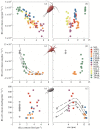Silicified cell walls as a defensive trait in diatoms
- PMID: 31014222
- PMCID: PMC6501939
- DOI: 10.1098/rspb.2019.0184
Silicified cell walls as a defensive trait in diatoms
Abstract
Diatoms contribute nearly half of the marine primary production. These microalgae differ from other phytoplankton groups in having a silicified cell wall, which is the strongest known biological material relative to its density. While it has been suggested that a siliceous wall may have evolved as a mechanical protection against grazing, empirical evidence of its defensive role is limited. Here, we experimentally demonstrate that grazing by adult copepods and nauplii on diatoms is approximately inversely proportional to their silica content, both within and among diatom species. While a sixfold increase in silica content leads to a fourfold decrease in copepod grazing, silicification provides no protection against protozoan grazers that directly engulf their prey. We also found that the wall provides limited protection to cells ingested by copepods, since less than 1% of consumed cells were alive in the faecal pellets. Moreover, silica deposition in diatoms decreases with increasing growth rates, suggesting a possible cost of defence. Overall, our results demonstrate that thickening of silica walls is an effective defence strategy against copepods. This suggests that the plasticity of silicification in diatoms may have evolved as a response to copepod grazing pressure, whose specialized tools to break silicified walls have coevolved with diatoms.
Keywords: diatoms; mechanical defence; silica wall; traits and trade-offs; zooplankton grazing.
Conflict of interest statement
We declare we have no competing interests.
Figures




Similar articles
-
Grazing-induced changes in cell wall silicification in a marine diatom.Protist. 2007 Jan;158(1):21-8. doi: 10.1016/j.protis.2006.09.002. Epub 2006 Nov 1. Protist. 2007. PMID: 17081802
-
Architecture and material properties of diatom shells provide effective mechanical protection.Nature. 2003 Feb 20;421(6925):841-3. doi: 10.1038/nature01416. Nature. 2003. PMID: 12594512
-
Induction of domoic acid production in diatoms-Types of grazers and diatoms are important.Harmful Algae. 2018 Nov;79:64-73. doi: 10.1016/j.hal.2018.06.005. Epub 2018 Jul 2. Harmful Algae. 2018. PMID: 30420018
-
Diatom/copepod interactions in plankton: the indirect chemical defense of unicellular algae.Chembiochem. 2005 Jun;6(6):946-59. doi: 10.1002/cbic.200400348. Chembiochem. 2005. PMID: 15883976 Review.
-
Mandibular gnathobases of marine planktonic copepods - feeding tools with complex micro- and nanoscale composite architectures.Beilstein J Nanotechnol. 2015 Mar 6;6:674-85. doi: 10.3762/bjnano.6.68. eCollection 2015. Beilstein J Nanotechnol. 2015. PMID: 25821707 Free PMC article. Review.
Cited by
-
Mechanism of branching morphogenesis inspired by diatom silica formation.Proc Natl Acad Sci U S A. 2024 Mar 5;121(10):e2309518121. doi: 10.1073/pnas.2309518121. Epub 2024 Feb 29. Proc Natl Acad Sci U S A. 2024. PMID: 38422023 Free PMC article.
-
The Co-Evolution Aspects of the Biogeochemical Role of Phytoplankton in Aquatic Ecosystems: A Review.Biology (Basel). 2023 Jan 6;12(1):92. doi: 10.3390/biology12010092. Biology (Basel). 2023. PMID: 36671784 Free PMC article. Review.
-
Algal blooms in the ocean: hot spots for chemically mediated microbial interactions.Nat Rev Microbiol. 2024 Mar;22(3):138-154. doi: 10.1038/s41579-023-00975-2. Epub 2023 Oct 13. Nat Rev Microbiol. 2024. PMID: 37833328 Review.
-
Predator-induced defence in a dinoflagellate generates benefits without direct costs.ISME J. 2021 Jul;15(7):2107-2116. doi: 10.1038/s41396-021-00908-y. Epub 2021 Feb 12. ISME J. 2021. PMID: 33580210 Free PMC article.
-
Diatoms for Carbon Sequestration and Bio-Based Manufacturing.Biology (Basel). 2020 Aug 10;9(8):217. doi: 10.3390/biology9080217. Biology (Basel). 2020. PMID: 32785088 Free PMC article. Review.
References
-
- Mortensen B. 2013. Plant resistance against herbivory. Nat. Educ. Knowl. 4, 1–5.
-
- Jakobsen HH, Tang KW. 2002. Effects of protozoan grazing on colony formation in Phaeocystis globosa (Prymnesiophyceae) and the potential costs and benefits. Aquat. Microb. Ecol. 27, 261–273. (10.3354/ame027261) - DOI
Publication types
MeSH terms
Substances
Associated data
LinkOut - more resources
Full Text Sources

